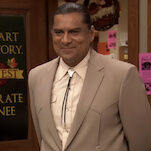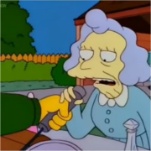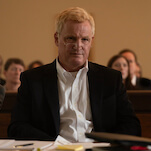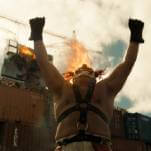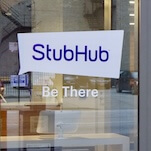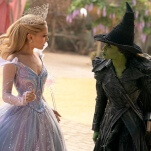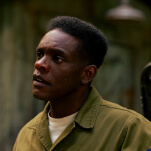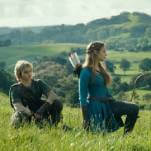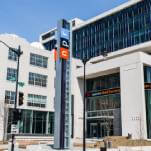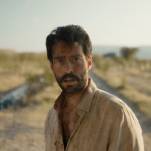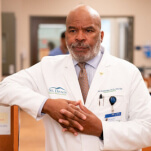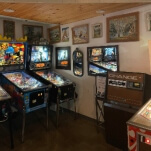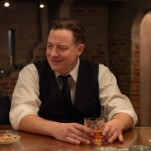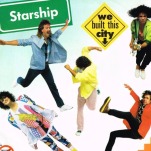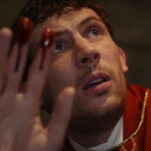Today:
When: Ferris drops off Cameron’s father’s car so the gang can traipse around the city.
How it’s changed: Is that tree new? That tree looks new!
The Art Institute Of Chicago (111 S. Michigan Avenue)
In the film:
Today:
When it appears in the film: Ferris, Sloane, and Cameron stop at the Art Institute on their perfect day off.
How it’s changed: Flags! Actually, this downtown area has even more to offer now than it did in Ferris’ day, accounting for the increased foot traffic in the modern picture. Since 1985, the city has added Millennium Park, the Pritzker Pavilion for live performances, the Lurie Garden, the Crown Fountain, the Bean… we think Ferris et al. should plan a return trip. They could even make a day of it.
Georges Seurat’s A Sunday On La Grande Jatte (European Wing of the Art Institute)
In the film:
Today:
When it appears in the film: Cameron is entranced by this painting to the tune of an instrumental version of “Please, Please, Please, Let Me Get What I Want” by The Smiths.
How it’s changed: The Seurat masterpiece has been reframed, and that looks like new trim on the walls. Otherwise, not much has changed at all, although that’s a matter of perspective: Seurat’s pointillist painting method fascinated not only Cameron but countless museum visitors, as the colors and composition of the image appear to change depending on your distance from it.
Below the Wells El Track (near the intersection of Madison Street and Wells Street, Chicago)
In the film:
Today:
When it appears in the film: The attendants drive away from the parking garage and kick off their joyride on this street, whooping all the way.
How it’s changed: Barely at all. The lighting’s a little different, but aside from an occasional coat of paint, these El train girders probably haven’t been touched in 60 years. And that’s optimistic. Maybe a pothole got fixed? (Of course not. Chicago humor.)
The Willis Tower, f.k.a. Sears Tower (233 S. Wacker Drive, 103rd Floor, Chicago)
In the film:
Today:
When it appears in the film: Ferris, Sloane, and Cameron looking down upon their city.
How it’s changed: Not too much. It looks like that plant has been replaced by a trash can, and there’s additional observation-deck telescopes and larger reinforced wall struts between windows. Our little tower is growing up!
The Willis Tower Observation Deck, view of street level
In the film:
Today:
When it appears in the film: About two seconds after we first see them up there.
How it’s changed: In the awesomest way possible. You can now stand on the glass and look down! It’s an acrophobe’s worst nightmare, but then again, acrophobes probably aren’t ascending the Tower in the first place.
Prime Ferrari-jumping roadway (Near 1500 S. Clark Street, Chicago)
In the film:
Today:
When: The Ferrari flies through the air as the two parking lot attendants take it for a spin.
How it’s changed: It barely looks like the same area. As Chicago’s downtown reached full capacity, the city stretched southward, and luxury condos and lofts were built by savvy developers taking advantage of the area’s proximity to downtown. Trendy restaurants and stores (Whole Foods, Starbucks, Chicago’s own Portillo’s) followed. Now these lucky residents won’t even miss that George Lucas museum.
Wrigley Field (1060 W. Addison Street, Chicago)
In the film:
Today:
When it appears in the film: Ferris and company attend a ball game, and the stadium flashes its support of Chicagoland’s supposedly ill young hero.
How it’s changed: There’s been some cosmetic surgery, albeit not much. Wrigley Field is an institution, and nobody’s likely to mess up its facade much unless asbestos gets discovered in the bleachers. That top window area has gotten strengthened, though, and the marquee sponsor is now Toyota rather than Budweiser.
Save Ferris Water Tower (1201 Cedar Lane, Northbrook, Illinois)
In the film:
Today:
When it appears in the film: Ferris’ distraught classmates and admirers even use a water tower to help raise funds for his (unbeknownst to them, fictional) illness.
How it’s changed: John Hughes spent his formative years in Northbrook, at Glenbrook North High School, where Ferris picks up Sloane. So Hughes asked Northbrook village officials if he could paint over their water tower for his movie message, and they reasoned that they had to paint the water tower every dozen years or so anyway, so why not? The tower is currently blank—it doesn’t even proclaim the village name. But Northbrook has not forgotten its Hughes-ian legacy: The village recently installed a John Hughes memorial bench with a perfect vantage point of the now-unadorned structure.
Chez Quis (22 W. Schiller Street, Chicago)
In the film:
Today:
When it appears in the film: Ferris pretends to be Abe Froman, the Sausage King Of Chicago, and scores a table for himself, Cameron, and Sloane at this fancy French restaurant.
How it’s changed: What was once portrayed in the film as the epitome of snootiness—all ivy-covered with a Jag out front—is now more of a bland brick facade that might be a touch fancy but lacks that sense of old-money snobbery.
Federal Center (230 S. Dearborn Street, Chicago)
In the film:
Today:
When it appears in the film: Cameron and Sloane waltz around a stunning piece of art while gushing over Ferris, as if they have nothing else worth discussing in their lives.
How it’s changed: People still stroll by the Federal Center and Alexander Calder’s Flamingo sculpture without stopping to take it in, probably because they’re talking about their asshole friend who ditched them to be in a parade—but hey, isn’t he great?
Parade route (intersection of Dearborn Street and Calhoun Place, Chicago)
In the film:
Today:
When it appears in the film: During the parade, obviously. This particular corner is glimpsed during Ferris’ performance of “Twist & Shout.”
How it’s changed: There’s a bike lane now, and the building at 33 North Dearborn revised its rather austere “33 NORTH DEARBORN BUILDING” signage. The real changes can be seen in the next block north, where brick and stone gave way over the years to glass and steel.
Exelon Plaza (31 S. Clark Street, Chicago)
In the film:
Today:
When it appears in the film: Dancers stage a colorful display of choreography on the stairs during the parade.
How it’s changed: This may be the saddest picture of all. Instead of a joyous, flash-mob-worthy line dance to “Twist And Shout,” we have soul-crushed middle management trying to squeeze a few moments of sunshine out of their lunch breaks. These people are like Cameron all grown up. Ferris would slap the bejeezus out of them.
Glencoe Beach (160 Hazel Avenue, Glencoe, Illinois)
In the film:
Today:
When: Cameron goes catatonic two-thirds of the way though Ferris’ day off.
How it’s changed: This overlook (which is actually located closer to the end of Park Avenue than Glencoe Beach’s official Hazel Avenue address) still looks like a great spot to lose your shit. The lovely wall and the benches both remain—the latter having been replaced at least once since the ’80s—and Lake Michigan looks stunning, of course.
The Buellers’ suburban neighborhood (intersection of Berkeley Avenue and Cherry Street, Winnetka, Illinois)
In the film:
Today:
When it appears in the film: Jeanie Bueller takes this corner at high speed as she races to beat her brother home and expose his fake illness.
How it’s changed: The comedy of this shot stems from the fact that Jeanie creates her own personal speedway in the context of a quiet, upscale bedroom community. So it’s fitting that this street corner has apparently seen little action over the past 30 years, although that sapling by the stop sign is all grown up now.
Katie Bueller’s office (538 Chestnut Street, Winnetka, Illinois)
In the film:
Today:
When it appears in the film: Principal Rooney’s quest to defeat his most insolent pupil begins with a call to Ferris’ mom; this establishing shot shows us the classy suburban downtown area where she works.
How it’s changed: Aside from slightly rearranged flora and a traffic sign, we strained to find anything different in the present-day incarnation of this attractive office building/shopping center. The town of Winnetka apparently doesn’t believe in change for change’s sake.




